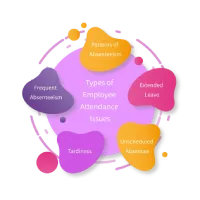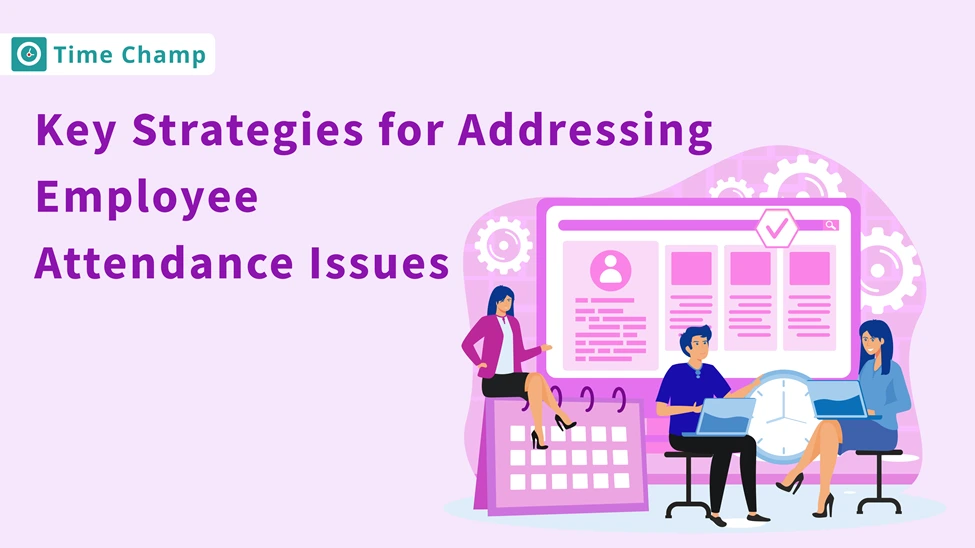Attendance problems are becoming more common and harder to manage. Whether it is frequent lateness, unexpected absences, or missing work often, these issues can quickly affect productivity and team spirit. Hence, addressing the employee attendance issues is important before they cause more trouble for your team.
The good news is that all these issues can be addressed. If you identify the root cause and take the right steps then you can easily address employee attendance issues, keep your team morale high, and prevent bigger problems from happening.
Why Do Businesses Need to Address Attendance Issues?
Attendance issues usually seem minor in the beginning, but they can lead to bigger problems when left without attention. A lack of addressing these attendance issues can cause the work to slow down, projects to be delayed and team members to feel more stress as they help out. Unresolved problems can result in high levels of employees leaving the company. Companies need to invest more energy and money in hiring and training new employees. All these added costs can reduce the company’s profits.
Addressing such problems in the beginning allows businesses to keep up their performance, improve their teams’ culture and avoid setbacks that can hurt their profits. A company with strong attendance manages its tasks better, reaches its goals more often and can grow as a result.
Types of Employee Attendance Issues

There are several types of employee attendance issues that can affect workplace efficiency; here are the most common ones.
- Frequent Absenteeism: When an employee regularly misses work without a valid reason.
- Tardiness (Late Arrivals): When employees often arrive late at work, it affects schedules and creates a negative impression.
- Unscheduled Absences: When employees miss work without prior notice. This disrupts team plans and increases workload on others.
- Extended Leave: When an employee takes a long break from work, usually for personal, medical, or family reasons.
- Patterns of Absenteeism: Refer to repeated absences that follow a noticeable trend, like missing work every Monday or before the holidays.
Key Strategies to Address Employee Attendance Issues

Simple, effective solutions exist to handle work attendance problems. Employers can improve workplace performance by identifying problems and establishing appropriate solutions to increase employee presence. The following steps represent the basic solutions which address work attendance problems:
Clear Attendance Policies
Create an attendance policy which provides clear guidelines about employee time management at work. These policies explain employee absences through descriptions of sick day permissions and vacation permissions along with consequences for absence without explanation.
Flexible Work Options
Provide flexibility for employees to choose their work hours and places both within and outside normal business locations with flexible work arrangements. Employees with the choice of their work timing and location have lower stress and improved attendance as they are able to maintain a good work-life balance. Flexible work arrangements give employees more control over their work, increasing motivation and encouraging better performance.
Open Communication
Encourage open communication, employees can feel comfortable discussing their issues from work or personal life. If the employees share everything freely with you then it becomes easy to simplify attendance issues.
Employee Wellness Programs
Set up Employee wellness programs, services, or activities that maintain workers' physical and mental health, making them feel good. Employee wellness programs reduce stress while improving moods and maintaining health, that produces higher job attendance and performance outcomes.
Employee Recognition and Rewards
Recognize employee efforts and reward them to show appreciation for a job that is done well. Provide appreciation bonuses, special gifts, and compliments as performance rewards. Employees who experience appreciation show increased workplace motivation while maintaining job satisfaction along with regular attendance. When employees feel valued, they stay motivated and committed to their work responsibilities.
Consistent Monitoring and Follow-Up
Keep an eye on employee attendance patterns and talk directly with workers about any performance problems. By regularly checking in, you can spot issues quickly and fix them before they get worse.
Possible Causes of Attendance Issues
Attendance problems can happen for many reasons, both personal and work-related. Knowing what causes them can help you to solve the issue. Here are some of the common reasons for attendance issues.

Health-related Issues
Health-related issues arises when employees get sick or health conditions which prevent them from showing up at work. Short-term or long-term health conditions can cause employees to become unable to attend work. In such situations you must show understanding by staying in constant communication with sick employees while providing any available help during health-related absences.
Personal or Family Problems
Personal or family problems can make it hard for an employee to come to work. This could be looking after a sick family member, having trouble at home, or dealing with other personal matters. These things can be stressful and may affect how often the employee shows up. Being kind and offering help can really make a difference.
Lack of Motivation or Job Dissatisfaction
Employees who lack motivation, combined with job dissatisfaction, can create a situation where work performance gets worse. A worker loses motivation and job satisfaction when their work brings them neither happiness nor fulfillment. Lack of interest, recognition, and unhappiness makes workers to either remain at home or perform tasks without dedication. A positive workplace environment will boost their mood while simultaneously increasing their drive.
Burnout and Stress
Burnout and stress happen when an employee feels really tired or stays under too much pressure for a long time. This can make them lose energy, stop caring about their work, and miss more days. Giving those breaks, support, and a fair amount of work can help them feel better.
Inadequate Work-Life Balance
When employees dedicate excessive work hours instead of family time or rest and enjoyable activities, they experience a work-life imbalance. Excessive work reduces their energy and causes stress that leads to increased absence from work.
Conclusion
To wrap it up, workplace productivity and employee morale are important for employers when addressing attendance problems. Addressing the employee attendance issues starts with understanding various attendance types and their causes. By Implementing clear rules and flexible working options and encouraging open communication channels along with wellness programs, You can improve employee attendance and increase their overall morale.
Regular check-ins combined with employee recognition helps employers to develop more motivated teams, which results in reduced problems and leads to consistent company success.
Frequently Asked Questions
Good attendance means work gets done on time and teams stay focused. When employees show up regularly, it builds trust, helps people work better together, and keeps everything running smoothly, helping the business grow.
Yes. Bonuses combined with additional time off and simple expressions of appreciation can create feelings of value among employees. People who experience appreciation tend to attend work more often and perform at their highest level.
Absolutely. Even if someone works from home, keeping track of their attendance helps you understand their work habits, share tasks fairly,and support them if they have problems, while making sure everyone stays on track.
Use best attendance tracking tool like, Time Champ. It serves as a time and productivity tracking application which reveals worker activity along side their working hours through its simple interface. This tool provides instant data updates that enable error reduction and enables early detection of problems.
If you ignore attendance problems, they can spread. Work might slowdown, deadlines get missed, and other employees can get frustrated. This leads to low morale, unhappy customers, and even losing good workers.








